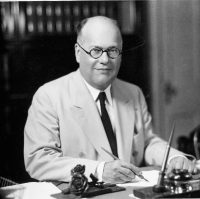R. Gray Williams was the most influential person in the development and construction of John Handley High School. An attorney, he became the President of the Handley Board of Trustees in 1915 and immediately faced significant challenges.
The executors of John Handley’s will had not completed their work after 20 years. Williams and the Trustees had to take the executors to court in 1916 in order to access the funds for the Handley Foundation schools.
The Handley will established that the money was to be used to educate the poor of Winchester. Williams led the effort to create an independent school district that did not include Frederick County schools.
Local elected officials said there were no poor to educate in Winchester as a result of the strong economy. Williams worked to demonstrate the importance of public education for the entire community.
Unlike John Kerr’s will, Handley’s will did not stipulate the money be used to educate only white children. Powell W. Gibson became the Principal of the school on East Piccadilly Street in 1916 and had the name changed from the Winchester Colored School to the Douglas School that year. Williams and Gibson worked together to improve the educational system for the Black community.
Gray Williams contacted the General Education Board (GEB), part of the John D. Rockefeller Foundation, for advice. The GEB recommended using the Handley trust money in a public – private partnership with public money used to pay for operations and trust money used to build schools and to fund non-traditional programs.
The GEB recommended constructing one large imposing building for white students that would make an impression. It recommended building a significantly smaller school for the Black population as well as hiring a full time superintendent and better paid teachers for a newly created Winchester Public Schools division.
Williams encouraged the GEB to recommend building the school on a large site and to emphasize the need for playgrounds and athletic fields. He had a site in mind: a 72 acre parcel at the south end of Washington Street known as the Equity property. The parcel had been purchased in 1890 by John Handley and, as part of the Handley estate, was owned by the Trustees. John Handley had designated a portion of the property as a school site.
Citizens on the north side of Winchester were opposed to the Equity site. Their children would have to walk all the way across town to a school site that was partially in the county.
With access to the funds and with the recommendations of the GEB, Gray Williams led the effort to build the first Handley Foundation school. In early 1919, he started the largest building project in the history of the city while he addressed a less than supportive city council, a general population reluctant to spend tax dollars for educating “the poor”, citizens on the north side of town objecting to the location of the school, post World War I material shortages coupled with inflation, and the flu epidemic.
In the fall of 1923, the Handley School opened with Winchester students in elementary, junior high and senior high programs housed in the same building. The endowed public school was truly unique.
R. Gray Williams was President of the Handley Board of Trustees for 25 years. He led the Board through the building of the Handley School. Four years later he led the Board through the building of the Douglas School that was followed by the building of the Virginia Avenue Elementary School on the north side of town.
